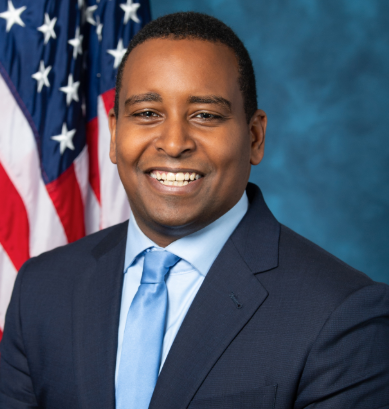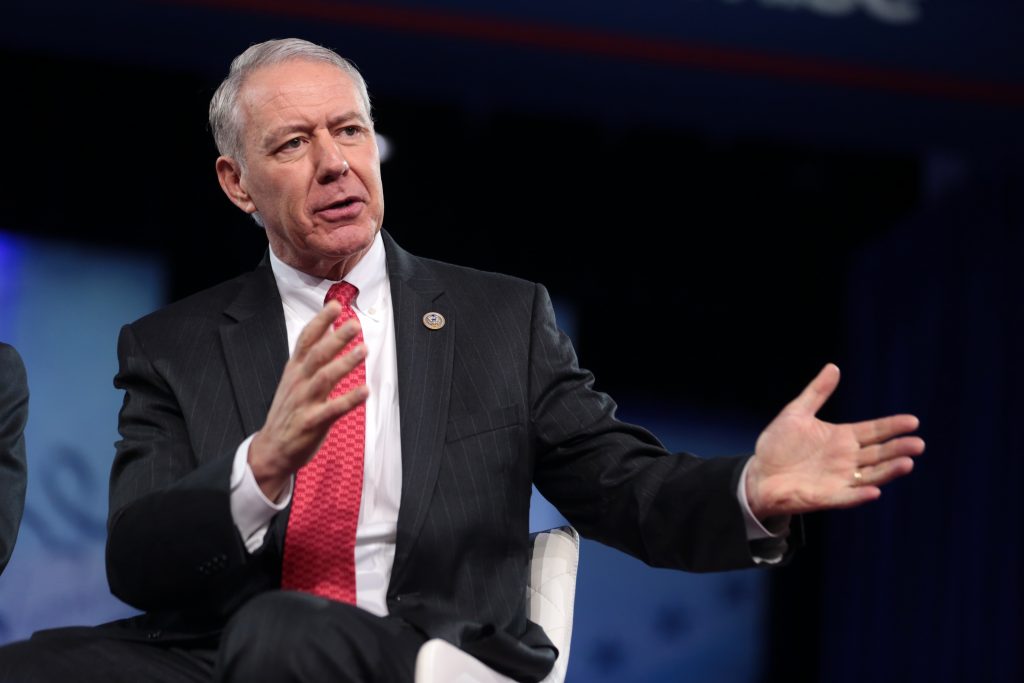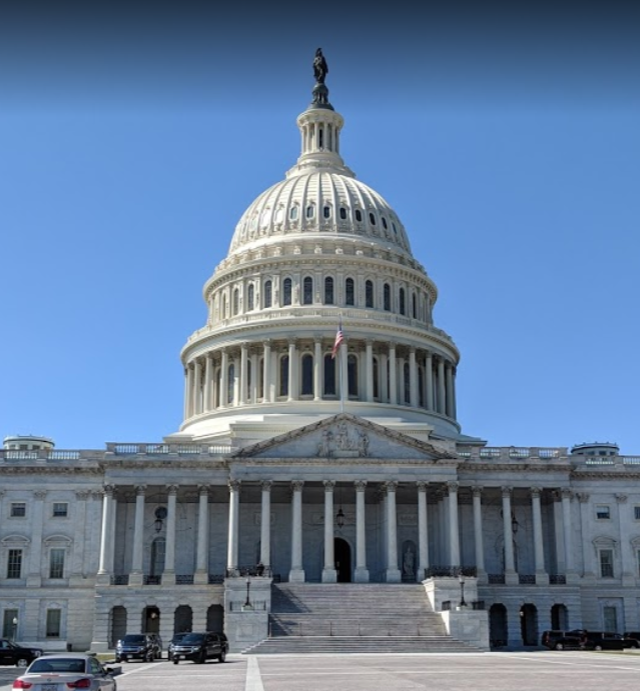WASHINGTON — During a combative hearing Wednesday on how to end the gun violence epidemic in the United States, Congressman Joe Neguse, a Boulder Democrat, said “assault weapons have no place in civilian hands,” while, at the same hearing, Republican Congressman Ken Buck, of northern Colorado, said the AR-15 is needed to kill “predators that are trying to disturb individuals, or trying to kill chickens or disturbing agriculture in some way.”
“Military-style assault weapons have no place in civilian hands,” Neguse said at the hearing, citing the Columbine and Aurora movie theater shootings. “They have no place in schools, theaters, and in communities. In Colorado, we know this all too well.”

Neguse criticized fellow members of the committee for their lack of courage to address gun violence.
In contrast, Buck displayed a photo of himself holding an AR-15, decorated with the American flag, with former Rep. Trey Gowdy (R-SC), a fierce opponent of gun-safety laws, to illustrate how this type of weapon is often used to hunt raccoons and foxes in his district.

“From my experience, in my district, an AR-15 is used to kill animals that are predators that are trying to disturb individuals, or trying to kill chickens or disturbing agriculture in some way,” Buck said.
Buck co-sponsored the Concealed Carry Reciprocity Act of 2019 (H.R.38), which would allow a gun owner to bring their handgun across state lines so long as they conceal it.
As he did on Fox News last week, Buck blamed gang members for more than 90 percent of violent crimes in the United States, but this statistic appears to be inaccurate, according to a witness at the hearing as well a fact check conducted by the Colorado Times Recorder. According to the National Gang Center, fewer than one-third of law enforcement agencies reported that they regularly record each of seven major categories of offenses as “gang-related.”
The U.S. House Judiciary Committee’s hearing Wednesday featured a debate, for the first time in years, about a ban on assault-style weapons
Rep. Debbie Mucarsel-Powell (D-FL) gave an emotional statement about her high-school daughter after a video by the Sandy Hook Promise played.
Her daughter told her just before she was set to speak with survivors and experts on gun violence that there was an active-shooter drill.
“If she can’t get into her classroom, she would try to talk to the shooter and tell him or her to remember his little brother or sister, to not shoot. This what our children now have to deal with,” Mucarsel-Powell said.
“Today’s hearing is about whether America will tolerate weapons of war on our streets and in our neighborhoods,” Rep. Jerry Nadler (D-NY), chairman of the committee, said. “We’ll soon discover whether the Republican leadership of the Senate is still in abject fealty to the gun manufacturers or not when they consider this legislation.”
The Federal Assault Weapons Ban of 1994 expired in 2004, and, in the decade that the ban was in effect, 89 people died from 12 mass shootings. From 2004 to 2014, more than 300 people died from 34 shootings. On average, 100 people die per day due to gun violence.
In the wake of the mass shootings last month in El Paso, Texas, and Dayton, Ohio, lawmakers clashed during a contentious hearing on a bill introduced by Rep. Ted Deutch (D-FL) to ban large-capacity magazines.
“I understand that this is not easy for everyone, but I want everyone to understand how for the lives that have been ripped from the face of this earth,” Deutch said, before pausing for a few moments. “For their families, it will never be the same.”
A national, comprehensive model
“We will not comply with any efforts by the Democratic leftists. We will not comply with any efforts to ban or confiscate our legal guns,” a protestor erupted before escorted out of the room.
The hearing quickly turned into a debate on definitions as members dribbled in and out of the room.
Charlottesville Police Department Chief of Police RaShall Brackney accused lawmakers of attempting to derail the conversation for claiming the widely-shared belief that only a good person with a gun could stop a bad person.
“Actually what stops a bad person with a gun is keeping a gun out of their hands to start with,” Brackney said, followed by a sea of applause. “Ask that from any law enforcement officer who’s ever had to look down the face of a barrel, go tell that to their families, their widowers, their children, and tell that to the community and all of those persons from all of those mass shootings that we’re going to argue about definitions versus the impact that it’s having on our communities.”
David Chipman, senior policy advisor at the nonpartisan organization Giffords, argued in favor of a comprehensive national approach to tackling gun violence because, he said, many of the guns used to commit crimes in cities like Chicago, which have strong gun laws, often come from interstate travel.
“I was just in Denver, and we’re talking to people there focused on the issue of gun violence. Half of their crime guns come from other states,” Chipman said.
Colorado is no stranger to gun violence — the 1999 mass shooting at Columbine High School was one of the first instances of school shootings in the United States. The state Legislature since then banned high-capacity ammunition magazines, and firearm purchasers must pass a background check first.
In April, Colorado lawmakers also passed a so-called ‘red flag,’ which allows law enforcement officials to confiscate a gun owner’s firearms if it’s proven, to the satisfaction of a judge, that they are a danger to themselves or others.
The law is set to go into effect next year, and Neguse argued that his state’s law could become a national model.
Neguse yielded some of his time to Rep. Lucy McBath (D-GA), who lost her son to gun violence in 2012, before speaking.
‘I blame myself for her death’
The committee also heard from local officials and first responders on the impact of mass shootings on communities. Dayton Mayor Nan Whaley described the crime scene the following morning after nine people died and dozens were injured in August.
“The thing I remember most clearly is the smell of bleach. A street sweeper was being used to try to clean the road and men in hazmat suits were scrubbing the sidewalks. The meat still sat on the grill of the taco truck. Little yellow placards showing where bullet casings were found looked like they had been scattered without thought. I was in a place that was both completely familiar, and completely foreign,” Whaley said.
“And yet, we were lucky,” she added.
Whaley emphasized during the hearing that the community is still grappling with what unfolded. With each shooting that has occurred since, she added, “the whole community goes through the shooting again.”
Dr. Alejandro Rios Tovar, a trauma surgeon at University Medical Center of El Paso, compared treating patients after the mass shooting, where more than 20 people died following the mass shooting in Texas, to being inside of a warzone.
“We did save 13 of the 14 patients that arrived to us,” Tovar testified. “But that first patient haunts me every night. I wish I could have done more and I blame myself for her death.”
Although a majority of the patients treated after the El Paso shooting were older, Rep. Sheila Jackson-Lee (D-TX) asked Tovar what injuries a child would have if they were shot by an automatic weapon.
“It’s not something that I would even want to think about imagining, but it would be devastating. It’s just not something that I can answer, I’m sorry,” Tover said.




